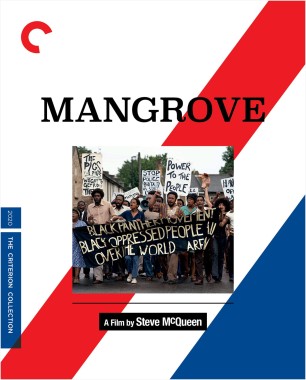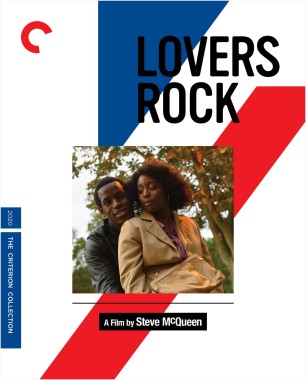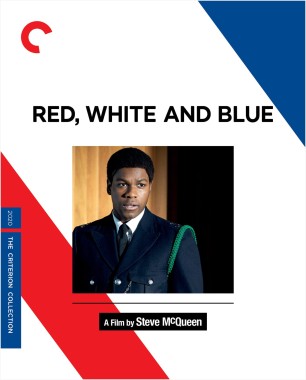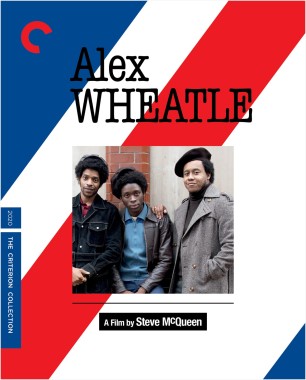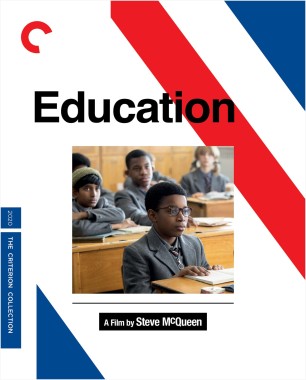
A suite of five thematically and stylistically connected films, Steve McQueen’s Small Axe is a multilayered and illuminating portrait of a community that has not received enough care or attention: London’s West Indian population from the late 1960s to the early 1980s. The series opens with Mangrove, which dramatizes in intimately detailed and thrillingly epic fashion a crucial slice of British history: the lead-up to and unfolding of a sensational 1971 trial in which a group of nine Black activists of West Indian heritage stood accused of inciting a riot during a planned demonstration against instances of racist police harassment. These repeated abuses targeted patrons of a Caribbean restaurant called the Mangrove, a thriving hub for intellectuals and artists in the West London district of Notting Hill, then a major focal point of Black culture in the United Kingdom.
As McQueen’s film depicts, after a grueling fifty-five-day trial at the Old Bailey (as London’s Central Criminal Court is colloquially known), the Mangrove Nine were acquitted, leading to the first-ever judicial recognition of “evidence of racial hatred” in London’s Metropolitan Police force. In Mangrove’s climactic sequence, one of the activists, Darcus Howe—whose lilting, imperious cadences are mimicked with spellbinding accuracy by the magnetic Malachi Kirby—fervently declares to a rapt courtroom that the case “has seared the consciousness of the Black community to an extent that the history of Britain cannot now be written without it.” But despite the galvanizing force of Howe’s words in this electrifying speech—adapted by McQueen and cowriter Alastair Siddons from the actual court transcripts—they would not be fully mirrored by reality in the decades following the trial.
Like many of the cast and crew members of Small Axe, I grew up as an inheritor of the history that Mangrove relates. My grandparents moved from Jamaica to London in the 1950s as part of the Windrush generation (named after a ship that docked in Tilbury, England, in 1948, bringing people from Jamaica, Trinidad and Tobago, and other Commonwealth islands to help fill vacancies caused by postwar labor shortages). My father was born in London and plied his trade as a reggae musician in venues such as Mau Mau Bar on Portobello Road, a three-minute walk from the former site of the Mangrove, which eventually closed in 1992 after years of gentrification and continued police harassment. Despite the work that Black British artists, scholars, writers, and organizers had done to keep its memory alive, the story of the Mangrove Nine was nowhere to be found in the textbooks I was assigned at school. Portraits of organized Black British community resistance were largely absent from national newspapers, television, and cinema screens. Films that yanked back the veil on anti-Black police brutality and institutional racism—Franco Rosso’s The Mangrove Nine (1973) and Babylon (1980), Horace Ové’s Pressure (1976), David Koff’s Blacks Britannica (1978), Ceddo Film and Video Workshop’s The People’s Account (1985)—were banned, suppressed, or hamstrung by meager distribution.

When it arrived in 2020, after the many years of research and development that followed its initial commissioning by the BBC, Small Axe became the highest-profile attempt to bring this history to the screen. In addition to Mangrove, McQueen’s anthology of films includes an impressionistic portrait of a West London blues party circa 1980 (Lovers Rock), two intense character studies of young Black British men and their divergent experiences with the law (Red, White and Blue and Alex Wheatle), and a piercing glimpse at a community’s fight against the stigmatization of Black children by the nation’s school system (Education).
The history that McQueen explores was made all the more visible by the fanfare surrounding the series. Small Axe marked a triumphant return to home soil for a British filmmaker who had conquered Hollywood, becoming, with 2013’s 12 Years a Slave, the first Black director of a Best Picture Oscar winner. Had the 2020 edition of the Cannes Film Festival not been canceled on account of COVID-19, McQueen would have become the first director in the festival’s history with two films (Mangrove and Lovers Rock) in the same competition lineup. Nevertheless, the grand scale of Small Axe’s subsequent international presentation—with prime-time TV slots, opening-night gala screenings at both the BFI London and New York Film Festivals, and a North American streaming engagement on Amazon Prime—felt seismic. This, at last, was the writing into history of which Mangrove’s Howe speaks.
The title of Small Axe derives from an African proverb popularized in Jamaica by Bob Marley and the Wailers’ 1970 song of the same name, whose lyrics (“If you are the big tree / We are the small axe”) point to the David-and-Goliath dynamic between a marginalized community and a country not set up to nurture it. Throughout the anthology, we see aspects of the “big tree” of British society: violently racist police officers, brutal courtroom guards, condescending educators. More fascinating, though, are the ways that McQueen portrays the workings of the “small axe,” which is no blunt instrument but an intricate weapon forged by the personal sacrifices, strained relationships, contrasting approaches, philosophical conundrums, courage, and angst that come with the territory of standing up against an oppressive system.
Mangrove’s protagonist—restaurant owner Frank Crichlow (TV and stage veteran Shaun Parkes)—is a popular pillar of the community but not a natural rabble-rouser, in contrast to activists like Howe and Altheia Jones (Letitia Wright). His path to embracing direct action is incremental. Having seen the demise of his prior establishment, the less-than-salubrious El Rio Café, Crichlow is determined to keep his hands clean. He is initially reluctant to allow Jones to hold Black Panther meetings at the Mangrove, and relents only when, in a gently humorous scene, she agrees to play the steel pan at an upcoming street party. It’s clear why Crichlow is so protective of the restaurant. In one of the most moving exchanges in Small Axe, a Jamaican elder, Mrs. Tetley (Doreen Ingleton), visits him there after a destructive police raid. She insists on giving him her savings, which she had been planning to use to return to the Caribbean one day. “The Mangrove is part of this story and me need to say this,” she explains. “This ah the place what make me know this really my home from home now.”
At the end of Mangrove’s first act, an exasperated Howe confronts Crichlow, urging him to embrace his—and the restaurant’s—status as a crucible for change. “I see a man before me, right? A man of great patience and humility, who, unbeknownst to him, has become a leader of his people,” Howe says before going on to invoke the teachings of the Trinidadian Marxist theorist C. L. R. James (a real-life Mangrove regular, briefly portrayed in the film by Derek Griffiths, a stalwart of British children’s TV). The intense tone and stark composition of the scene—shot with a fixed camera at medium height, and with the two actors on opposite sides of the frame—call to mind the pivotal seventeen-minute shot in McQueen’s feature debut, Hunger (2008), that shows Father Dominic Moran (Liam Cunningham) attempting to dissuade Irish Republican Army hunger striker Bobby Sands (Michael Fassbender) from starting his harrowing protest. But unlike Sands, who had reached a plane of activist fervor from which he could not and would not descend, the hitherto reluctant Crichlow ascends to action only after being riled. Soon after his breakthrough, the march from the Mangrove begins, and history’s spark is ignited.

In the Small Axe universe, Frank Crichlow finds an analogue in the form of Education’s Agnes Smith (Sharlene Whyte), the mother of a twelve-year-old aspiring astronaut named Kingsley (Kenyah Sandy), who is dismissed by his teachers as a troublesome “blockhead” and unceremoniously shunted away to an institute for the “educationally subnormal”—a dysfunctional holding pen masquerading as a school, overseen by chronically disaffected pseudoteachers. Although the characters in the 1970s-set Education are fictional, London councils did at the time transfer disproportionate numbers of Black children from the mainstream education system to such schools. (Education is the most autobiographical film in the series. McQueen, a first-generation West Londoner whose parents immigrated from Trinidad and Grenada, lived some aspects of Kingsley’s experience of being undervalued in the school system, though he dreamed of art instead of space travel.)
Initially, Agnes, who works two jobs to make ends meet and is characterized as devoutly religious, turns her anger toward Kingsley and fails to sufficiently question the patronizing headmaster of his school. Instead, she brands Kingsley “nothing but a heap of trouble.” The circumstance of a child being placed in harm’s way by an elder Caribbean immigrant’s implicit trust in the authority of the “mother country” reminds me of an anecdote my father told me from his own youth. On his way back from a friend’s house in South London, he was apprehended at a London Underground stop by a police officer, who accused him of pickpocketing. He spotted an elderly Caribbean woman on the platform and met her eye, hinting that he needed assistance. The woman looked at the officer, then at my father, then back at the officer, and said: “Lock ’im up!” In an ironic twist, he was let go only after he produced the Jehovah’s Witness leaflet that had been foisted on him by his friend’s sister. My father tells the story with a wry smile, but I have always wondered how he absorbed the pain of that kind of betrayal.
Agnes is visited by a Black education activist, Lydia (Josette Simon), who encourages her to join a community group, and hands her a leaflet and a copy of the Grenadian author Bernard Coard’s pathbreaking 1971 book How the West Indian Child Is Made Educationally Sub-normal in the British School System. But Agnes frostily tucks these materials away. A great amount of the dramatic tension in Education hinges on whether she will return to them and read them, overcome her deeply internalized shame, and attend one of the group’s meetings. Fortunately, she, like Frank Crichlow, finds the strength to participate.

Agnes’s decision leads to a series of scenes that are among the most excruciatingly tender McQueen has ever directed. These include a depiction of a community meeting at which one elder (Trevor Laird) seems to shed a lifelong burden to publicly state that he cannot read but that he is there to support the next generation; a moment of tearful catharsis when Agnes finally confronts the reality that her son can’t read; and a quiet, emotionally pulverizing sequence in which Kingsley’s older sister, Stephanie (Tamara Lawrance), reads passages from Coard’s book aloud to her illiterate manual-laborer father, Esmond (Daniel Francis). As Stephanie gives voice to Coard’s unsparing appraisal of the effects of a poor education, she might as well be describing to her father’s face the trials of his own life.
McQueen made a late decision to close Small Axe with Education because he found it to be the most hopeful and forward-looking of the films—at its conclusion, Kingsley is happy and thriving with his nerdy, enthusiastic Black peers at a Saturday school, a gathering held in the home of a volunteer educator in the community. The film’s grace notes are hard-won, though. Education ends with a visual representation of outer space, doubling for the inside of Kingsley’s head as he immerses himself in African history, but McQueen and Siddons (who also collaborated with the director on the screenplays for Mangrove and Alex Wheatle) engineer a bleak cosmic joke a few minutes earlier. In a group meeting, Lydia mentions the recently appointed secretary of state for education, one Margaret Thatcher, as a potentially sympathetic ear.
The specter of Thatcher and her draconian right-wing administration (which commenced in 1979) haunts the period settings of Red, White and Blue and Alex Wheatle. These two films, the third and fourth in the Small Axe sequence, form a compelling diptych exploring the true stories of two Black men whose vastly different lives are irrevocably shaped by negative interactions with the police. Alex Wheatle (Sheyi Cole) starts out admiring the police but ends up feeling white-hot hatred in the face of their abuse. The real-life Wheatle—who grew up as an orphan, found joy through friendship and music in South London’s Brixton neighborhood, and ultimately settled into a successful career as a young-adult-fiction author—was imprisoned after the Brixton uprising of April 1981, an explosion of civil unrest in reaction to racist policing. That event followed on the heels of a traumatic incident in South London earlier that year: the New Cross fire of January 18, a still-unexplained conflagration at a house party that left thirteen young Black people dead. In Alex Wheatle, the protagonist and his friends discuss the fire and its victims in a somber sequence that culminates with an image of Alex alone, sitting on his bed, starting to softly sob. The crushing weight of the tragedy is a catalyst for his political awakening. McQueen then segues into a breathtaking black-and-white photomontage showing the aftermath of the fire—and the ensuing Black People’s Day of Action protest, organized by the New Cross Massacre Action Committee, a cohort that included Darcus Howe—set to a reading of Jamaican poet Linton Kwesi Johnson’s “New Crass Massahkah.” (Johnson and Wheatle both appear as interviewees in Uprising, a sensitive and detailed three-part documentary about the New Cross fire and the Brixton uprising codirected by McQueen and James Rogan. It was broadcast on the BBC in 2021 and functions as an essential companion to Small Axe.)
The protagonist of Red, White and Blue—research scientist turned police officer Leroy Logan (John Boyega, in a tremendously charismatic and driven performance)—sincerely believes that he can transform the system from the inside. This provokes the furious incomprehension of his father, Kenneth (Steve Toussaint), whose savage beating by the police—captured unflinchingly in an early scene—is a pivotal reason behind Leroy’s career change. McQueen clearly has empathy for Leroy, and the real-life Logan, who remained a policeman for thirty years, was a consultant on Red, White and Blue. But the compelling argument that the rest of Small Axe and Uprising build against the intractably racist British police force amplifies the sometimes painful loneliness of his quixotic quest.
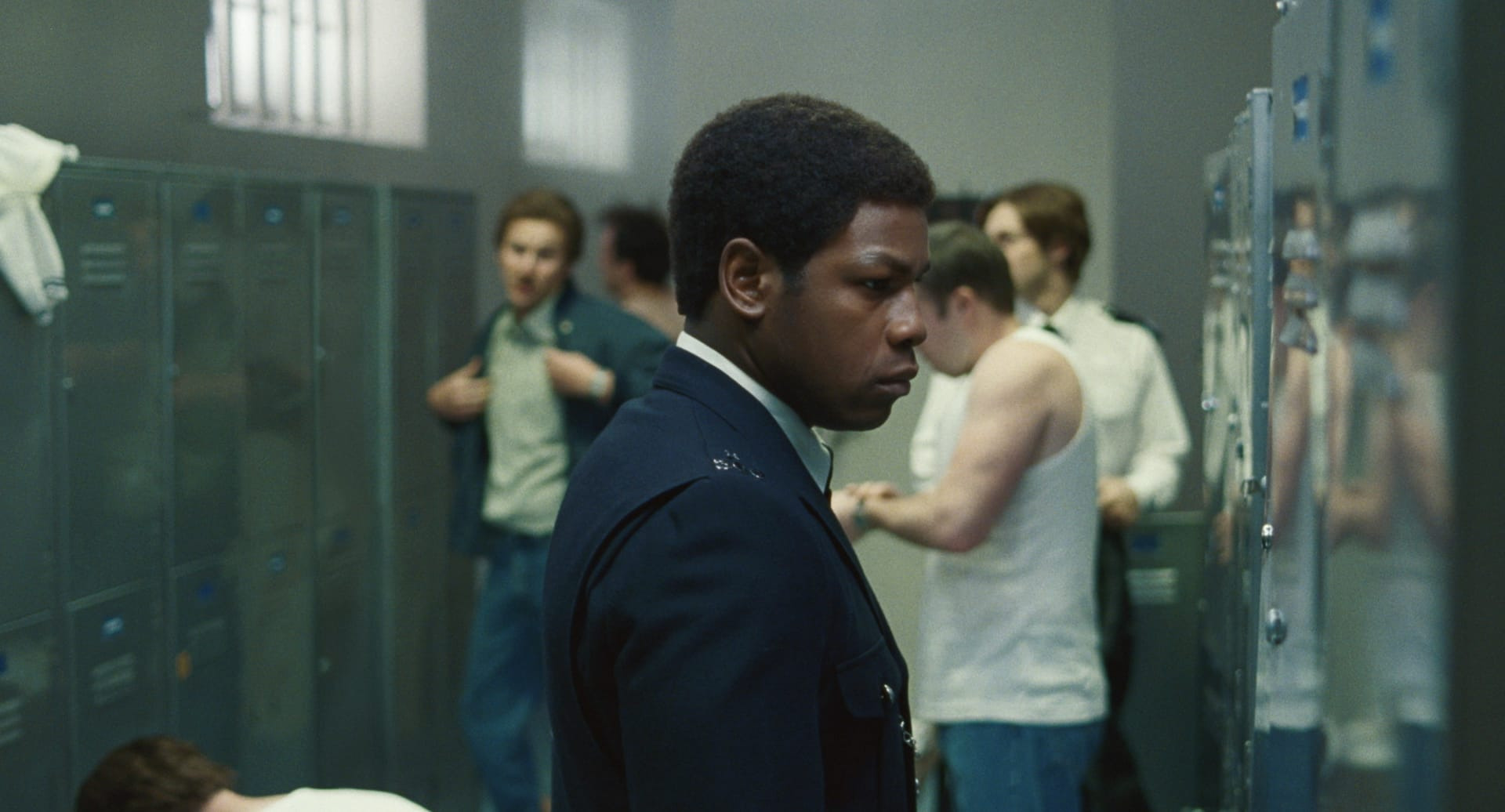
Lovers Rock is an outlier in Small Axe because its narrative is not explicitly concerned with an individual or a group butting heads with a hostile system. Yet its portrayal of a blues party as a source of spiritual nourishment for first-generation kids—a haven away from the scowling white racists who occasionally appear at the edges of the frame when the camera ventures outside the film’s domestic setting—feels no less political, especially when understood in light of the Mangrove story, in which the simple act of Black people congregating constituted a provocation in the eyes of the police. Lovers Rock is a strange and captivating film, structurally unorthodox and as unique in the annals of British cinema as it is in McQueen’s body of work. It ebbs and surges, with bursts of lovingly detailed action (close-ups of hands preparing food and constructing reggae sound systems) and snatches of dialogue between prospective young lovers punctuating long stretches of music and dance.
But the party is no utopia, and some of what happens there reflects McQueen’s propensity to engage with the dark, compulsive side of human nature in his films. A sexual predator at the gathering, Bammy (Daniel Francis-Swaby), attempts to rape Cynthia (Ellis George), whose seventeenth birthday is being celebrated at the party. And late in the film, a furious malcontent, Clifton (Kedar Williams-Stirling), arrives, jabbering about family discord. Both men end up subsumed into—and perhaps cleansed by—a dance to the juddering, swaggering dub monster “Kunta Kinte,” by Jamaican reggae band the Revolutionaries. McQueen stages this scene like a sweaty suburban baptism—feet thumping on the floor, ecstatic heads aloft, young men speaking in tongues, bodies bouncing compulsively across the carpet. At the end of this long night, the ostensible protagonist, Martha (Amarah-Jae St. Aubyn), who crept out of her bedroom window fairy tale–style at the start of the film, sneaks back home. No sooner has she climbed under the duvet and shut her eyes than an offscreen voice shouts, “Time for church! Time for church!” Martha smiles because, really, she has just come back from her generation’s own church—a private and sacred space of sonic bliss, passion and pain, heartbreak and romance.

If the themes of the Small Axe films are diverse yet unified, so are the aesthetic approaches used throughout the anthology. Shot by the brilliant young Antiguan cinematographer Shabier Kirchner, all the films have a respectfully and deliberately utilitarian visual style that prioritizes the legibility of content, space, and action over anything ornate, but McQueen uses a different format in each. The rich, sweeping Mangrove was shot on two-perforation 35 mm film that was intentionally over- and underdeveloped in processing to create a warmer, more artisanal image than digital cinematography could manage. For Red, White and Blue, Kirchner and McQueen opted for the less grain-heavy and more narrowly framed three-perforation 35 mm, resulting in a cleaner, starker look. Unlike the recognizably vibrant Brixton backdrops of Alex Wheatle (shot on the large-format Sony VENICE digital camera), Red, White and Blue’s London is a chilly, alien place scrubbed of character—an apt choice for this queasily tense film in which the conflicted protagonist is repeatedly isolated within the frame. Kirchner and McQueen chose to shoot Lovers Rock digitally, on an ARRI ALEXA, so they could capture long, fluid takes, and they also lit the environment from above, freeing the actors to move around the space in an authentic way. Most striking of all, Education was shot on Super 16 mm in the intimate, slightly jittery style of the BBC’s Play for Today drama films of the 1970s, including those directed by McQueen’s filmmaking hero Alan Clarke. The adoption of this particular visual schema to tell a story of Black British resistance on the BBC in 2020 is one of Small Axe’s subtlest and canniest strategies of writing itself into history. That look and feel would be instantly recognizable to an entire generation of Black British people who had never before seen themselves represented in that format, or in stories on-screen that unabashedly center their lives and experiences.
Throughout the series, McQueen offers imaginative flourishes that convey his dynamism and versatility (before he made Hunger, he had an established career as a Turner Prize–winning visual artist). In one masterful, effervescent sequence in Mangrove, Frank Crichlow attempts to calm his codefendant Rhodan Gordon (Nathaniel Martello-White), who is furious at the poor quality of the legal representation he is receiving. The screen suddenly cuts to black, and we hear the raucous vocals-only intro of “Skinhead Moonstomp,” by the ska band Symarip. As the song’s amphetaminic bongos kick in on the soundtrack, the film cuts to an overhead shot of a table in the courtroom, upon which a stop-motion collage of documents, trial evidence, and protest posters builds in concert with the skittering percussive noise. The song continues, its loping bass kicks in, and we see a wider shot of the courtroom as McQueen proceeds to lay image upon image and sound upon sound. The stenographer’s clacking keys become an equal partner in Symarip’s rhythm section as McQueen transitions into a photographic montage documenting the construction of the Westway motorway, a project that changed the face of the West London in which McQueen was raised at the cost of many locals’ housing and quality of life. The photographs turn from black and white to color, connoting the passage of time, and as the song fades out, McQueen takes us back into the courtroom. This extraordinary sequence functions as a narrative pressure valve and demonstrates McQueen’s ability to seamlessly blend the personal, the political, and the psychogeographical.
Small Axe also contains multiple examples of a McQueen trademark: shots held for an uncomfortable length of time. This confrontational method is as capable of lulling viewers into a trance as it is of forcing them to look. Its most disturbing iteration in McQueen’s oeuvre to date occurs in a scene in 12 Years a Slave, in which the camera holds for what seems like an eternity on the lynched figure of Solomon Northup (Chiwetel Ejiofor), his desperate, flexing toes struggling to touch the ground. There’s nothing quite so dire in Small Axe, but there is a haunting shot in the first few minutes of Alex Wheatle in which, following a fight with a racist classmate, Alex is apprehended by two equally bigoted adult staff members, placed in a straitjacket, and hurled to the ground in a school gym, the side of his face falling flat against the shiny surface. A widening shaft of light cuts from the left of the frame to the lower center, as if Alex’s soul is escaping his body. The camera pushes in until it is close to his prone face—his eyes are open yet deadened—and then comes to rest. After eighteen long seconds of stillness, something strange happens: the camera starts to retreat, slowly, as if embodying a person who wants to help but doesn’t know how and can only back away in silent defeat.

McQueen doesn’t use duration only to convey pain. In Lovers Rock, he finds an ecstatic, transcendent dimension in a drawn-out scene in which the partygoers sing along to Janet Kay’s romantic reggae hit “Silly Games” (among them is the song’s writer, UK reggae legend Dennis Bovell, in a brief cameo, his basso profundo cutting through the sound of the crowd). When the DJ stops the song, the revelers simply keep singing, and singing, and singing. An a cappella hymn is born, and the hostile world outside seems farther away than ever. In this moment, as in the rest of Small Axe, McQueen’s technical prowess is married with a deep sensitivity for the community he is depicting.
Small Axe’s five films played on consecutive Sunday evenings on the BBC One channel starting in mid-November 2020. This platform—the flagship outlet of Britain’s national broadcaster—was crucial for McQueen, because it allowed the widest possible range of people in the UK to experience his work. The morning after the broadcast of each installment, I logged in to Facebook and read the feeds of my father and his friends with glee. They were posting their own reviews, engaging in heated debates over minute details, reminiscing about musical reveries past, and sharing photographs of vintage fits sported on living-room dance floors that resembled the one painstakingly and poetically recreated in Lovers Rock by production designer Helen Scott. For all its educational and entertainment value, Small Axe prized open a vault of collective memory, loosened a faucet, lit a fire.
The series also emerged at a time when Britain, or at least the portion of British society possessing a moral conscience, was profoundly shaken by the Windrush scandal, which revealed that hundreds of Commonwealth citizens—many of them senior and frail—had been detained, denied legal rights, and in many cases deported as a result of a 2012 Conservative government policy to systematically create and enforce a “hostile environment” for immigrants. This was a torrid, unsettling time, after the first coronavirus lockdown, when young Black men in London—the equivalent of more than a quarter of all the city’s Black fifteen- to twenty-four-year-olds—were stopped and searched by police more than twenty thousand times, with over 80 percent of the searches conducted between March and May 2020 resulting in no further action. This was also a time of aftershock in the wake of senseless police killings of Black people in America—including Breonna Taylor in Louisville and George Floyd in Minneapolis—and the consequent antiracist uprisings and reckonings around the world.
A howl of endorsement for community resistance, as well as a vivid indictment of institutional malaise, Small Axe both met and was the moment. In its breadth, passion, and record-correcting stridency, it’s a momentous work, and an eruption of creativity from one of Britain’s most significant film artists. History cannot now be written without it.
More: Essays

David Byrne’s American Utopia: A Way We Could Work This
Amid the disorientation of the COVID-19 era, this rousing film cut through with a life-affirming reminder that community and connection are still possible.

David Byrne’s American Utopia: Here
Spike Lee captures the democratic spirit and the galvanizing, near-spiritual feeling of togetherness at the heart of David Byrne’s acclaimed stage production.

Pee-wee’s Big Adventure: Why Don’t You Take a Picture?
Paul Reubens’s iconic character comes to cinematic life in this collaboration with director Tim Burton, who creates an on-screen world that evokes the unbridled joy and overwhelming terror of childhood.

I Know Where I’m Going!: In the Wind
In one of cinema’s greatest love stories, Michael Powell and Emeric Pressburger use the mercurial beauty of Scotland’s Inner Hebrides to evoke the unruly passions of an indelible heroine.
